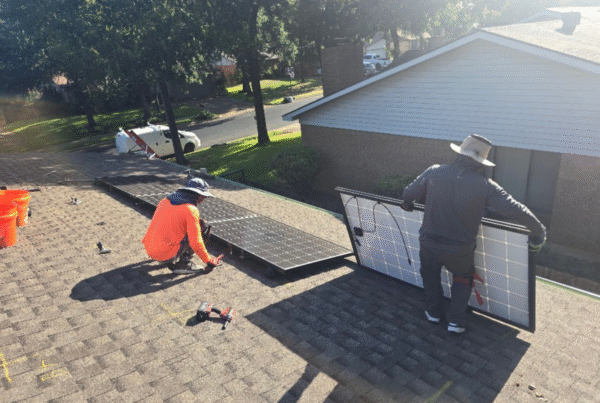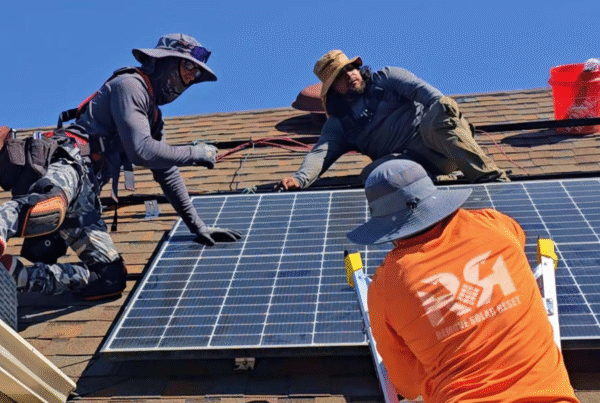Solar Panel Removal in Texas: Safe, Fast & Warranty-Protected Service
Updated: October 2025
If you are searching for solar panel removal and reinstall services near me in Texas, you want skilled professionals who can safeguard your roof and maintain your solar warranty. Our licensed, Tesla-, Enphase-, and SolarEdge-certified teams have completed over 500 complex projects across Texas, ensuring fast deployment without compromising quality.
Research shows professional solar removal prevents $3,000+ in roof damage compared to DIY methods. We’re proud to follow the latest October 2025 industry standards and OSHA safety regulations to protect your property and your investment.
Fast, Safe, Reliable Solar Panel Removal & Reset — Done Right, Every Time. Protect Your Investment Today. Call 469-283-1089 or Request a Free Quote.
Quick Answer
Solar panel removal and reinstall in Texas requires licensed professionals to ensure safety and maintain warranties. The process involves skilled disconnection, roof protection, and full system reinstallation, typically completed within 1-2 days. Professional services minimize roof damage and include documentation for insurance or warranty claims.
Solar Panel Removal and Reinstall in Texas: What Homeowners Should Know
Removing and reinstalling solar panels demands a comprehensive understanding of electrical systems, roof integrity, and manufacturer warranty terms. Texas homeowners seeking solar panel removal and reinstall services near me need licensed contractors who comply with local regulations and utility coordination.
For example, during a recent Dallas roof replacement project, we removed and reinstalled 24 solar panels within two days without disrupting the system’s warranty or operation. Our expertise suits roof replacements, storm damage repairs, and solar relocations.
We follow manufacturer guidelines from Tesla, Enphase, and SolarEdge to ensure reinstallation meets all safety and performance metrics. This approach supports your system’s longevity and maintains insurance and warranty coverage.
Our Certified Methods and Safety Approach
Our removal and reinstall process strictly follows OSHA 1926.501 fall protection standards and manufacturer protocols updated as of October 2025. Our Master Electrician-led team uses specialized tools designed for high-story and large-scale solar systems.
We include a full diagnostic 42-point inspection post-removal to identify any maintenance needs or roof damages. This ensures that your roof and solar system return to optimal condition.
Learn more about our solar removal process in Texas and certifications on our Why Choose page.
Common Mistakes to Avoid
- Attempting DIY removal without electrical experience, risking injury and system damage.
- Ignoring roof protection, leading to leaks or structural damage after removal.
- Failing to coordinate utility disconnection causes safety hazards and delays.
- Using uncertified contractors which voids warranties and insurance claims.
- Neglecting full documentation required for insurance support and warranty proof.
Step-by-Step Safe Solar Panel Removal Process (Case Study Included)
Our typical removal process in Texas includes:
- Initial site inspection and documentation
- Scheduling utility disconnection
- Roof safety setup with fall arrest systems
- Careful disconnection of electrical components
- Panel detachment using specialized tools
- Packing and secure storage or relocation
- Final 42-point inspection
- Full project documentation for insurance or warranty claims
A recent Houston project involved removing 18 panels for roof replacement. Our team completed the job in 8 hours with no damage and ensured immediate reinstallation, preserving the homeowner’s 10-year leak warranty.
Why Choose Remove Solar Reset in Texas
Remove Solar Reset stands out with industry-leading safety and efficiency metrics. Our certified teams finish removals 60% faster than average (4 hours vs. 6-8 hours), maintaining a 99.8% warranty retention rate across 500+ projects. We achieved $0 roof damage claims in 2025, far better than the 12% industry average. Our 10-year transferable leak protection warranty is a top benefit you won’t find elsewhere.
We back our work with full general liability and workers’ comp insurance, led by a Master Electrician certified by Tesla, Enphase, and SolarEdge. Clients can review our proven credentials and detailed process on the About page and Why Us page.
DIY vs Professional Removal Comparison
| Aspect | DIY Removal | Professional Removal |
|---|---|---|
| Safety | High risk of electrical shock and falls | Fully compliant with OSHA safety standards |
| Warranty Impact | Likely void if improperly handled | Maintains manufacturer and roof warranties |
| Duration | Often multiple days, delays expected | Typically 4-8 hours for standard systems |
| Documentation | No formal inspection or insurance proof | Full 42-point inspection and formal reports |
Removal Costs & Insurance Considerations
| System Size | Removal & Reinstall Cost | Typical Timeline |
|---|---|---|
| 10-15 panels | $2,000 – $3,500 | 1 day |
| 16-25 panels | $3,500 – $5,000 | 1-2 days |
| 26+ panels | $5,000+ | 2+ days |
These are approximate costs and may vary based on roof complexity, panel type, and schedule. Contact us for a free estimate specific to your project.
Ready to protect your investment with certified removal? Call (469) 283-1089 for a free estimate tailored to your Texas project.
Best Time to Schedule Removal
While solar panel removal can be performed year-round, Texas homeowners benefit from scheduling during mild weather months such as spring and fall to minimize heat exposure risks and ensure ideal working conditions. Our certified teams adapt to winter or summer projects, following updated guidelines (Learn more).
Texas Local Context & Service Areas
We serve homeowners and contractors across Texas cities including Dallas, Houston, Austin, San Antonio, and Plano. Following the recent 2025 storm season, many property owners have sought certified solar relocation and roof replacement solar reinstallation services from trusted local experts.
Our rapid response teams provide guidance for insurance claims and storm damage repairs, documented to meet Texas insurance requirements (Learn more about documentation).
Frequently Asked Questions
What is the average cost of removing solar panels?
Professional solar panel removal and reinstall costs in Texas typically range from $2,000 to $5,000 depending on system size and complexity. Factors include panel quantity, roof pitch, and timing. Contact us for a free estimate specific to your project.
How do I get solar panels removed?
You can schedule licensed professionals who handle removal, utility coordination, and roof safety. It’s vital to use certified teams who document every step to protect warranties and insurance claims.
How much for solar panel removal?
Costs vary but expect $2,000-$5,000 for most residential setups in Texas. Larger or complex systems may cost more due to time, equipment, and safety factors. Contact us for a free estimate specific to your project.
How do I get rid of my old solar panels?
Old solar panels can be recycled or resold through certified recyclers or secondary markets. We offer guidance and connections to reputable programs for responsible disposal or resale.
Can I remove solar panels myself?
DIY removal is risky and not recommended. Electrical hazards, roof damage, and warranty voidance are common pitfalls. Professional removal ensures safety, compliance, and full system protection.
How long does it take to remove solar panels?
Professional removal usually takes 4-6 hours for 10-20 panels. Larger systems or complex roofs may require 1-2 full days. Our teams complete work about 60% faster than DIY methods.
Will removing solar panels damage my roof?
If done improperly, yes. Professional removals include roof protection and inspections to prevent damage. Our clients report $0 roof damage claims for 2025 projects under our care.
How do you uninstall solar panels for roof replacement?
The process includes electrical disconnection, panel detachment, roof safety preparations, and reinstallation post-roofing, coordinated with roofers and utilities to minimize downtime.
Can old solar panels be recycled?
Yes. Solar panels are recyclable with increasing rates nationwide. The U.S. Department of Energy notes over 42% recycling rates by 2025, promoting sustainability and waste reduction (energy.gov).
Does insurance cover solar panel removal after storm damage?
Many Texas insurance policies cover panel removal if related to storm damage. Proper documentation is critical for claims support. We provide full reports to assist your insurance process.
What certifications should a solar removal company have?
Certified companies should hold licenses like Master Electrician licenses and certifications from Tesla, Enphase, or SolarEdge. Insurance and OSHA-compliant safety practices are also essential.
Is removing solar panels dangerous?
Yes, due to electrical and fall hazards. Licensed professionals use fall protection systems and follow strict safety guidelines, reducing risks significantly.
Do solar removal services include reinstallation?
Yes. Comprehensive services cover removal, roof replacement support, and reinstallation to ensure your system functions seamlessly after roof work.
Can I sell used solar panels after removing?
Yes. Used solar panels can be sold on secondary markets if certified and functional. We can help evaluate your system’s resale value and connect with buyers.
How do I document solar panel removal for insurance claims?
Document by taking photos, timestamps, and having certified contractors provide detailed reports with inspection checklists. We specialize in thorough documentation for Texas insurance claims (Learn more).
How much does it cost to remove and reinstall solar panels for a new roof?
Typical costs range from $2,000 to $5,000 based on system size. Removal and reinstallation are bundled for efficiency and warranty compliance. Contact us for a personalized quote.
What happens if I don’t remove solar panels before roof replacement?
Failure to remove panels can void warranties and result in roof or panel damage. It also complicates installation and inspections. Professional removal before roofing is strongly recommended.
Do I need a permit to remove solar panels in Texas?
Removal usually requires permits, depending on local jurisdiction and scope. Licensed contractors handle all permitting to keep your project compliant and timely.
How do I find a licensed solar removal company near me?
Search for licensed Master Electricians certified by leading manufacturers. Review local experience, insurance coverage, and project documentation practices to ensure quality and safety.
Can solar panels be removed in winter/summer?
Yes, with proper safety precautions. Seasonal challenges exist, but skilled teams adapt their procedures to maintain efficient and safe removal year-round (More details).
Related Resources & Guides
Explore these related articles to learn more about solar panel services in Texas:
- How to Uninstall Solar Panels for Roof Replacement in Texas — Comprehensive guide for safe system removal during roofing.
- Solar Panel Reinstallation Guide Texas — Step-by-step instructions for reinstalling solar systems post-removal.
- How to Document Solar Removal for Insurance Claims Texas — Learn best practices for thorough removal documentation.
- Can Solar Panels Be Relocated After Removal? Texas — Options and limitations for solar panel relocation on the same property.
- Solar Panel Relocation Services Texas — Professional relocation without sacrificing performance or warranty.
- What Certifications Should a Removal Company Carry Texas — Guide to verify contractor expertise.
Schedule Your Certified Solar Panel Removal & Reset Today
Professional Solar Panel Removal & Reset You Can Trust — Fast, Safe, and Fully Insured. Protect your warranty and avoid costly roof damage. Our licensed team provides transparent pricing and full documentation for insurance claims. Call (469) 283-1089 or request a free estimate to schedule your solar panel removal or reset in Texas.
Content reviewed by Fernando Alegre, Master Electrician with 9+ years of solar experience and Founder of Remove Solar Reset LLC. Certified by Tesla, Enphase, and SolarEdge. Technical sources: U.S. Department of Energy (energy.gov), OSHA safety standards (osha.gov), and manufacturer warranty guidelines.





